EX-99.1
Published on April 15, 2025

First Quarter 2025 Earnings Conference Call April 15, 2025 Exhibit 99.1
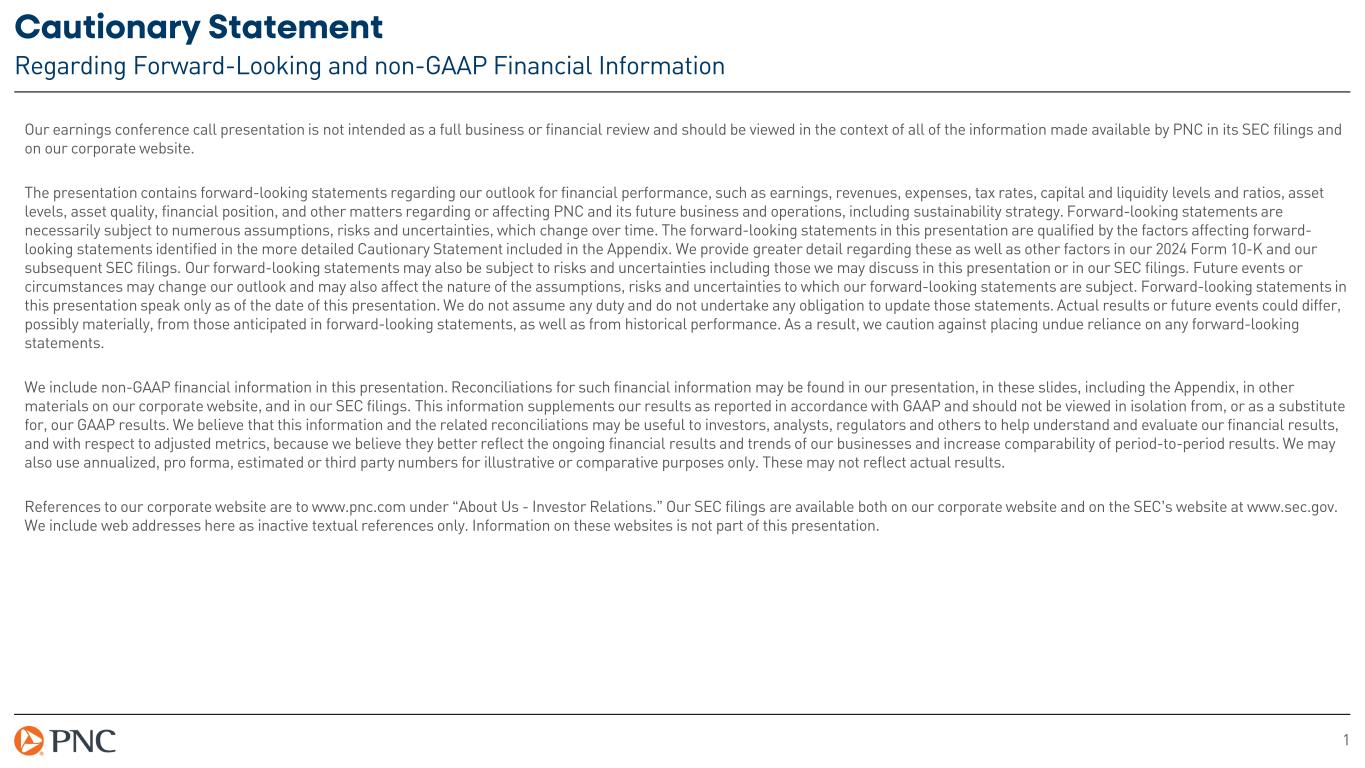
1 Cautionary Statement Regarding Forward-Looking and non-GAAP Financial Information Our earnings conference call presentation is not intended as a full business or financial review and should be viewed in the context of all of the information made available by PNC in its SEC filings and on our corporate website. The presentation contains forward-looking statements regarding our outlook for financial performance, such as earnings, revenues, expenses, tax rates, capital and liquidity levels and ratios, asset levels, asset quality, financial position, and other matters regarding or affecting PNC and its future business and operations, including sustainability strategy. Forward-looking statements are necessarily subject to numerous assumptions, risks and uncertainties, which change over time. The forward-looking statements in this presentation are qualified by the factors affecting forward- looking statements identified in the more detailed Cautionary Statement included in the Appendix. We provide greater detail regarding these as well as other factors in our 2024 Form 10-K and our subsequent SEC filings. Our forward-looking statements may also be subject to risks and uncertainties including those we may discuss in this presentation or in our SEC filings. Future events or circumstances may change our outlook and may also affect the nature of the assumptions, risks and uncertainties to which our forward-looking statements are subject. Forward-looking statements in this presentation speak only as of the date of this presentation. We do not assume any duty and do not undertake any obligation to update those statements. Actual results or future events could differ, possibly materially, from those anticipated in forward-looking statements, as well as from historical performance. As a result, we caution against placing undue reliance on any forward-looking statements. We include non-GAAP financial information in this presentation. Reconciliations for such financial information may be found in our presentation, in these slides, including the Appendix, in other materials on our corporate website, and in our SEC filings. This information supplements our results as reported in accordance with GAAP and should not be viewed in isolation from, or as a substitute for, our GAAP results. We believe that this information and the related reconciliations may be useful to investors, analysts, regulators and others to help understand and evaluate our financial results, and with respect to adjusted metrics, because we believe they better reflect the ongoing financial results and trends of our businesses and increase comparability of period-to-period results. We may also use annualized, pro forma, estimated or third party numbers for illustrative or comparative purposes only. These may not reflect actual results. References to our corporate website are to www.pnc.com under “About Us - Investor Relations.” Our SEC filings are available both on our corporate website and on the SEC’s website at www.sec.gov. We include web addresses here as inactive textual references only. Information on these websites is not part of this presentation.
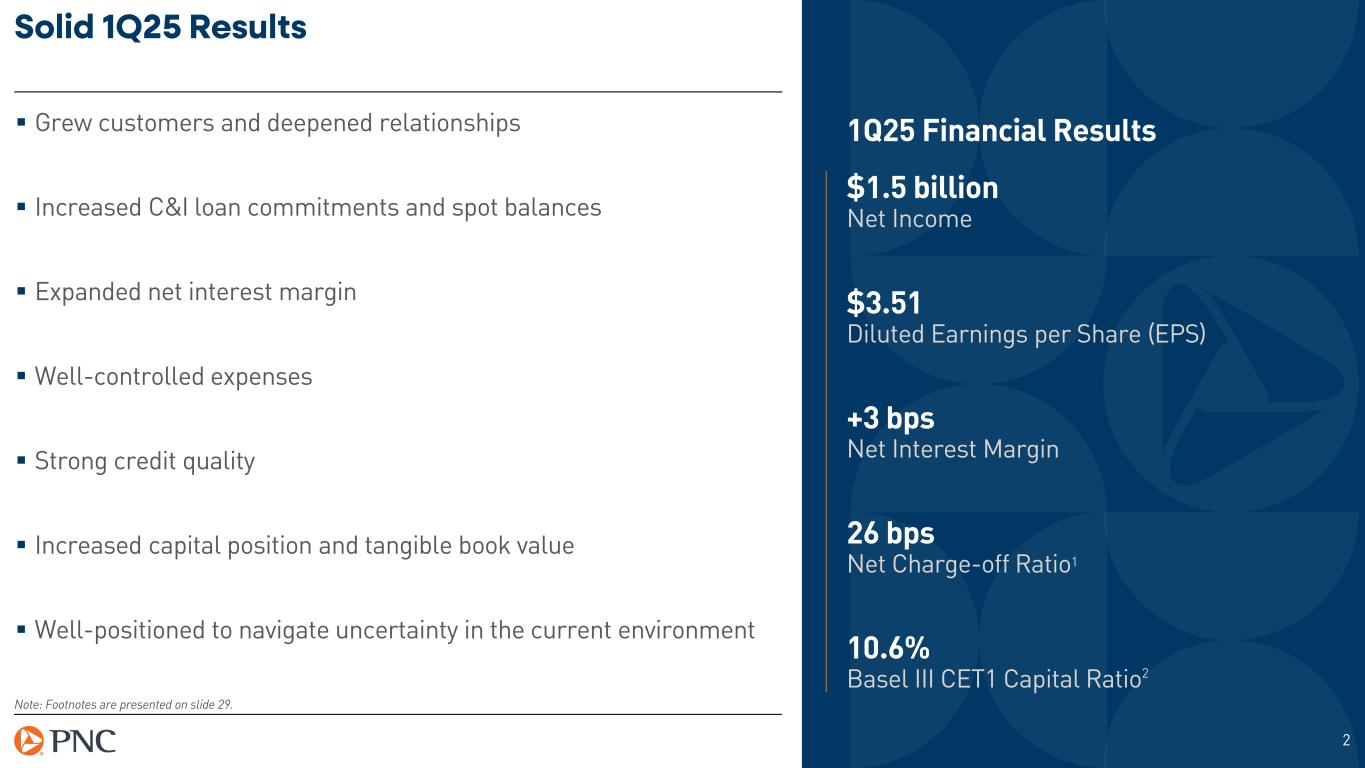
2 Solid 1Q25 Results Grew customers and deepened relationships Increased C&I loan commitments and spot balances Expanded net interest margin Well-controlled expenses Strong credit quality Increased capital position and tangible book value Well-positioned to navigate uncertainty in the current environment Note: Footnotes are presented on slide 29. $1.5 billion Net Income $3.51 Diluted Earnings per Share (EPS) 26 bps Net Charge-off Ratio1 +3 bps Net Interest Margin 10.6% Basel III CET1 Capital Ratio2 1Q25 Financial Results

3 Increased Capital Position Balance Sheet Summary Linked Quarter Year over Year Average balances, $ billions 1Q25 $ % $ % Total loans $316.6 $(2.4) (1)% $(4.0) (1)% Investment securities $142.2 $(1.7) (1)% $6.7 5% Federal Reserve Bank balances $34.2 $(3.3) (9)% $(13.6) (28)% Total deposits $420.6 $(4.6) (1)% $0.5 – Borrowed funds $64.5 $(2.7) (4)% $(11.1) (15)% Common shareholders’ equity $49.2 $0.7 2% $4.8 11% Period end 3/31/25 12/31/24 LQ 3/31/24 YoY AOCI ($ billions) $(5.2) $(6.6) $1.3 $(8.0) $2.8 Tangible book value per common share (non-GAAP) $100.40 $95.33 5% $85.70 17% Basel III CET1 capital ratio 10.6% 10.5% 10 bps 10.1% 50 bps Note: AOCI = accumulated other comprehensive income (loss). YoY = year-over-year. LQ = linked quarter. Totals may not sum due to rounding. For non-GAAP figures, see reconciliation in the appendix.

4 Average Loans Declined; Solid C&I Growth Drove Higher Quarter-End Balances Note: YoY = year-over-year. LQ = linked quarter. C&I = commercial and industrial. CRE = commercial real estate. Totals may not sum due to rounding. Consolidated Average Loan Balances Total loans declined 1% LQ, primarily driven by lower CRE balances $101 $100 $100 $219 $219 $217 $321 $319 $317 6.01% 5.87% 5.70% 1Q24 4Q24 1Q25 Consumer Commercial Total Loan Yield $ bi lli on s Consumer Loans (1)% LQ and (2)% YoY Total Loan Yield declined 17 bps LQ Commercial Loans (1)% LQ and (1)% YoY Spot Loan Roll-Forward C&I growth partially offset by declines in CRE and consumer $ bi lli on s C&IB Loan Utilization 12/31/24 C&I CRE Consumer 3/31/25 $316.5 $4.7 $(1.3) $(1.0) $318.9 49.5% 50.3% 49% 50% 51% 52% Ja n- 24 Fe b- 24 M ar -2 4 Ap r- 24 M ay -2 4 Ju n- 24 Ju l- 24 Au g- 24 Se p- 24 O ct -2 4 N ov -2 4 D ec -2 4 Ja n- 25 Fe b- 25 M ar -2 5 Spot Utilization Spot utilization increased ~80 bps in 1Q25
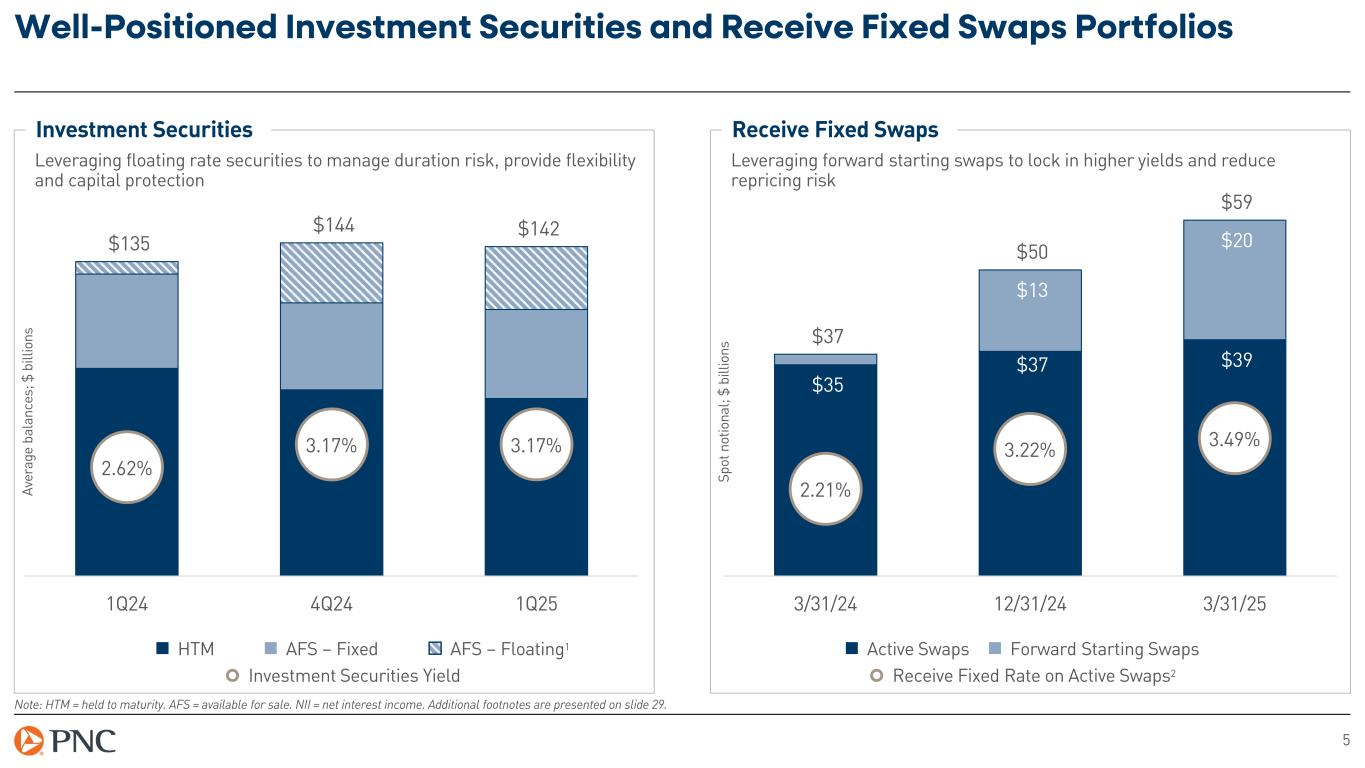
5 Well-Positioned Investment Securities and Receive Fixed Swaps Portfolios Note: HTM = held to maturity. AFS = available for sale. NII = net interest income. Additional footnotes are presented on slide 29. $135 $144 $142 2.62% 3.17% 3.17% 1Q24 4Q24 1Q25 Av er ag e ba la nc es ; $ b ill io ns $35 $37 $39 $13 $20 $37 $50 $59 2.21% 3.22% 3.49% 3/31/24 12/31/24 3/31/25 Receive Fixed Rate on Active Swaps2 Active Swaps Forward Starting Swaps Sp ot n ot io na l; $ bi lli on s HTM AFS – Floating1AFS – Fixed Investment Securities Yield Investment Securities Receive Fixed Swaps Leveraging floating rate securities to manage duration risk, provide flexibility and capital protection Leveraging forward starting swaps to lock in higher yields and reduce repricing risk

6 Stable Deposit Base Note: IB = interest-bearing deposits. NIB = noninterest-bearing deposits. Totals may not sum due to rounding. Additional footnotes are presented on slide 29. Consolidated Average Deposit Balances $99 $96 $92 $312 $321 $324 $10 $8 $5 $420 $425 $421 2.60% 2.43% 2.23% 1Q24 4Q24 1Q25 NIB IB, ex. Brokered CDs Brokered CDs Rate Paid on Total IB $ bi lli on s Cumulative deposit beta1 of 51% as of March 2025 Average Consumer Deposit Mix Average Commercial Deposit Mix $21 $21 $21 $187 $185 $188 $208 $206 $210 1Q24 4Q24 1Q25 NIB IB $78 $76 $71 $125 $136 $135 $203 $212 $206 1Q24 4Q24 1Q25 NIB IB $ bi lli on s $ bi lli on s

7 Strong Year over Year Performance Income Statement Summary Linked Quarter Year over Year $ millions except EPS 1Q25 $ % $ % Net interest income $3,476 $(47) (1)% $212 6% Fee income (non-GAAP) 1,839 (30) (2)% 93 5% Other noninterest income 137 (38) (22)% 2 1% Noninterest income $1,976 $(68) (3)% $95 5% Total revenue $5,452 $(115) (2)% $307 6% Noninterest expense 3,387 (119) (3)% 53 2% Pretax, pre-provision earnings (non-GAAP) $2,065 $4 – $254 14% Provision for credit losses 219 63 40% 64 41% Income taxes 347 69 25% 35 11% Net income $1,499 $(128) (8)% $155 12% Diluted EPS $3.51 $(0.26) (7)% $0.41 13% Key metrics 3/31/25 12/31/24 3/31/24 Noninterest income to total revenue 36% 37% 37% Net interest margin (non-GAAP) 2.78% 2.75% 2.57% Note: Net interest margin is calculated using taxable-equivalent net interest income, a non-GAAP measure. For non-GAAP figures, see reconciliation in the appendix.
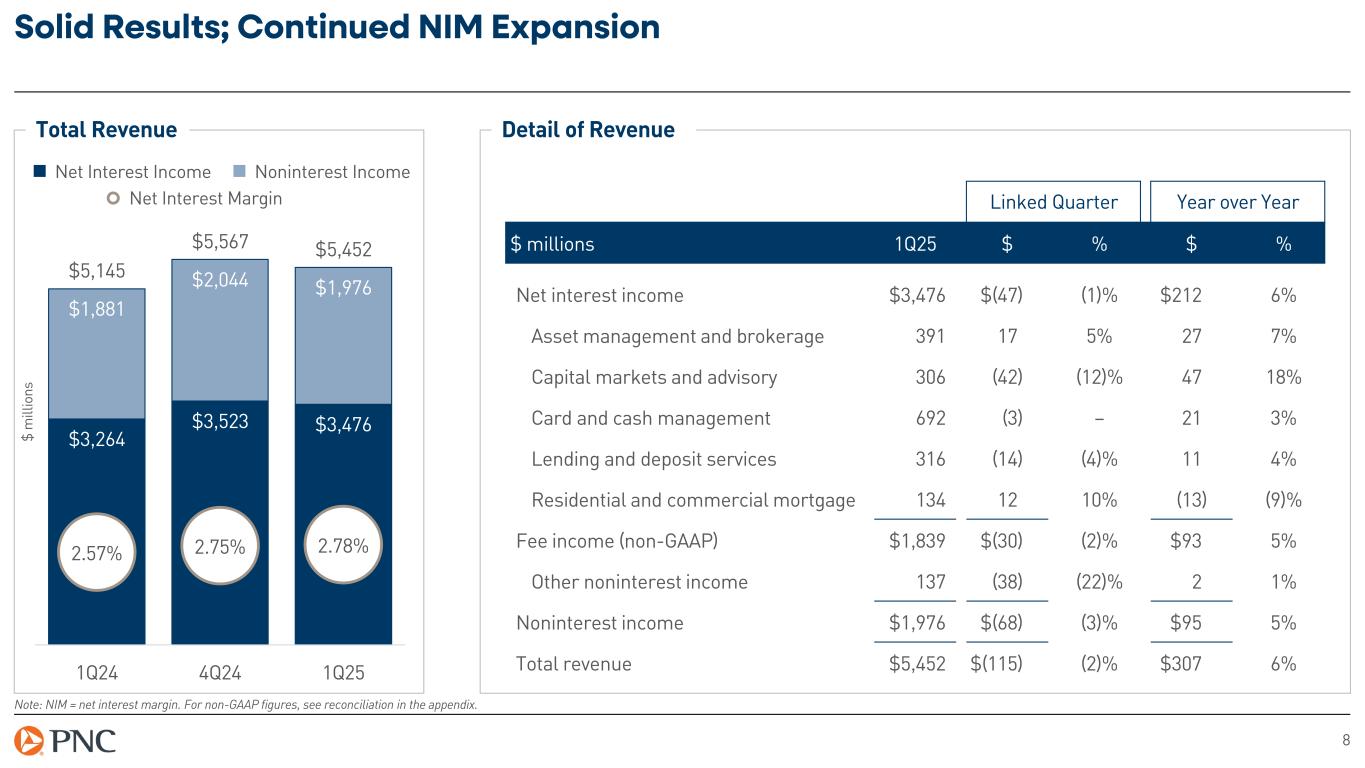
8 Solid Results; Continued NIM Expansion Note: NIM = net interest margin. For non-GAAP figures, see reconciliation in the appendix. Total Revenue $3,264 $3,523 $3,476 $1,881 $2,044 $1,976 $5,145 $5,567 $5,452 2.57% 2.75% 2.78% 1Q24 4Q24 1Q25 Linked Quarter Year over Year $ millions 1Q25 $ % $ % Net interest income $3,476 $(47) (1)% $212 6% Asset management and brokerage 391 17 5% 27 7% Capital markets and advisory 306 (42) (12)% 47 18% Card and cash management 692 (3) – 21 3% Lending and deposit services 316 (14) (4)% 11 4% Residential and commercial mortgage 134 12 10% (13) (9)% Fee income (non-GAAP) $1,839 $(30) (2)% $93 5% Other noninterest income 137 (38) (22)% 2 1% Noninterest income $1,976 $(68) (3)% $95 5% Total revenue $5,452 $(115) (2)% $307 6% Detail of Revenue Net Interest Income Noninterest Income Net Interest Margin $ m ill io ns
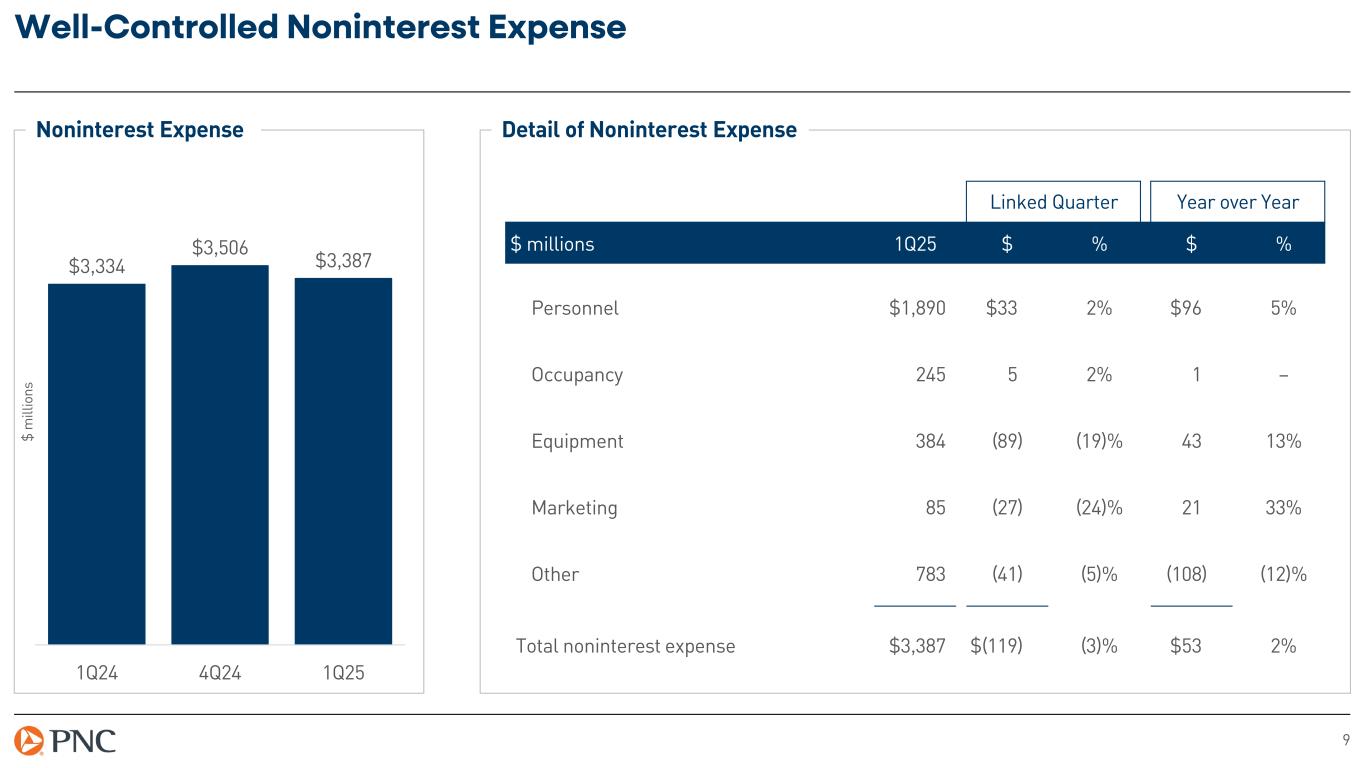
9 Well-Controlled Noninterest Expense Noninterest Expense $3,334 $3,506 $3,387 1Q24 4Q24 1Q25 Linked Quarter Year over Year $ millions 1Q25 $ % $ % Personnel $1,890 $33 2% $96 5% Occupancy 245 5 2% 1 – Equipment 384 (89) (19)% 43 13% Marketing 85 (27) (24)% 21 33% Other 783 (41) (5)% (108) (12)% Total noninterest expense $3,387 $(119) (3)% $53 2% Detail of Noninterest Expense $ m ill io ns
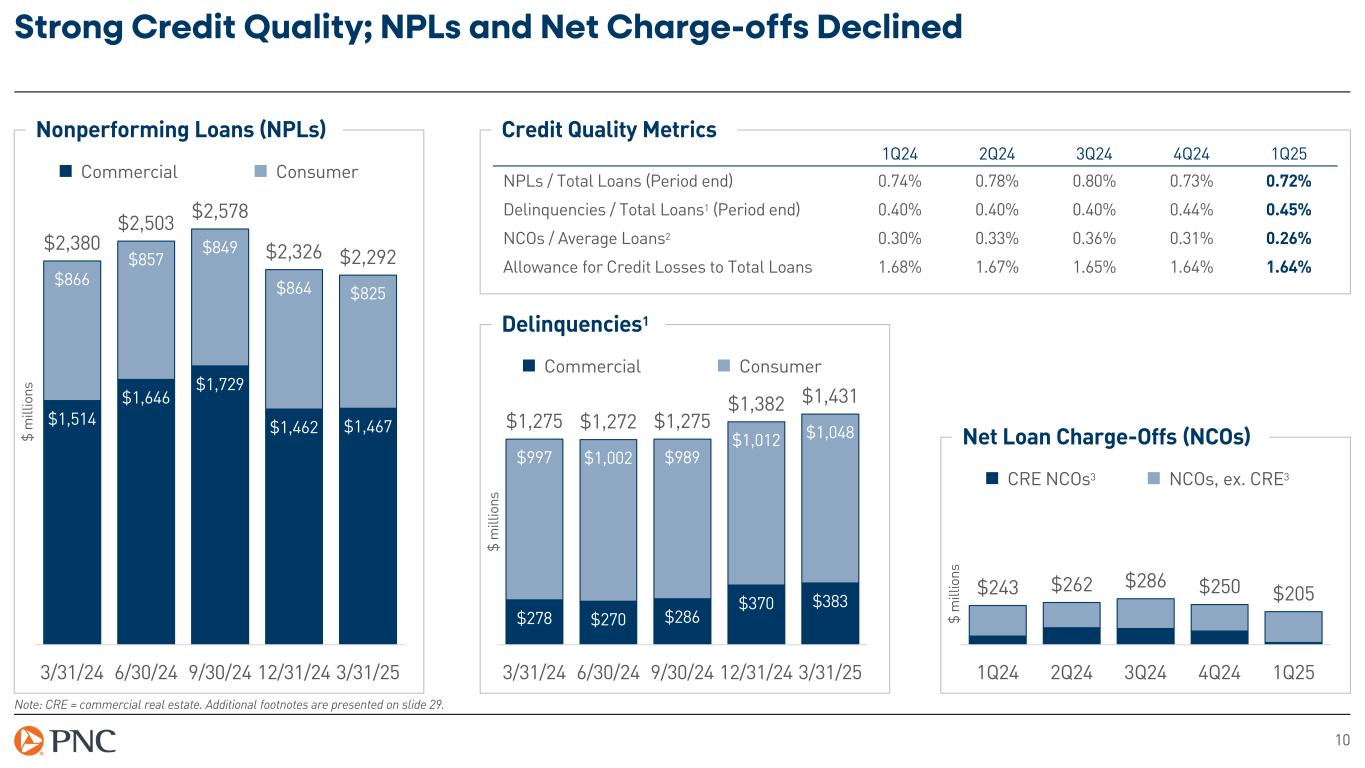
10 Strong Credit Quality; NPLs and Net Charge-offs Declined Note: CRE = commercial real estate. Additional footnotes are presented on slide 29. Nonperforming Loans (NPLs) Net Loan Charge-Offs (NCOs) Credit Quality Metrics $1,514 $1,646 $1,729 $1,462 $1,467 $866 $857 $849 $864 $825 $2,380 $2,503 $2,578 $2,326 $2,292 3/31/24 6/30/24 9/30/24 12/31/24 3/31/25 $278 $270 $286 $370 $383 $997 $1,002 $989 $1,012 $1,048$1,275 $1,272 $1,275 $1,382 $1,431 3/31/24 6/30/24 9/30/24 12/31/24 3/31/25 $243 $262 $286 $250 $205 1Q24 2Q24 3Q24 4Q24 1Q25 NCOs, ex. CRE3CRE NCOs3 Delinquencies1 Commercial Consumer $ m ill io ns $ m ill io ns $ m ill io ns 1Q24 2Q24 3Q24 4Q24 1Q25 NPLs / Total Loans (Period end) 0.74% 0.78% 0.80% 0.73% 0.72% Delinquencies / Total Loans1 (Period end) 0.40% 0.40% 0.40% 0.44% 0.45% NCOs / Average Loans2 0.30% 0.33% 0.36% 0.31% 0.26% Allowance for Credit Losses to Total Loans 1.68% 1.67% 1.65% 1.64% 1.64% Commercial Consumer

11 Full Year 2025 vs. Full Year 2024; Guidance Unchanged Note: Refer to Cautionary Statement in the Appendix, including economic and other assumptions. Does not take into account impact of potential legal and regulatory contingencies. Additional footnotes are presented on slide 29. $ millions; except loans, $ billions 2024 2025 Guidance1, 2 Average loans $319.8 Stable Spot loans $316.5 Up 2% – 3% Net interest income $13,499 Up 6% – 7% Noninterest income $8,056 Up ~5% Total revenue $21,555 Up ~6% Noninterest expense $13,524 Up ~1% Effective tax rate 17.8% ~19%
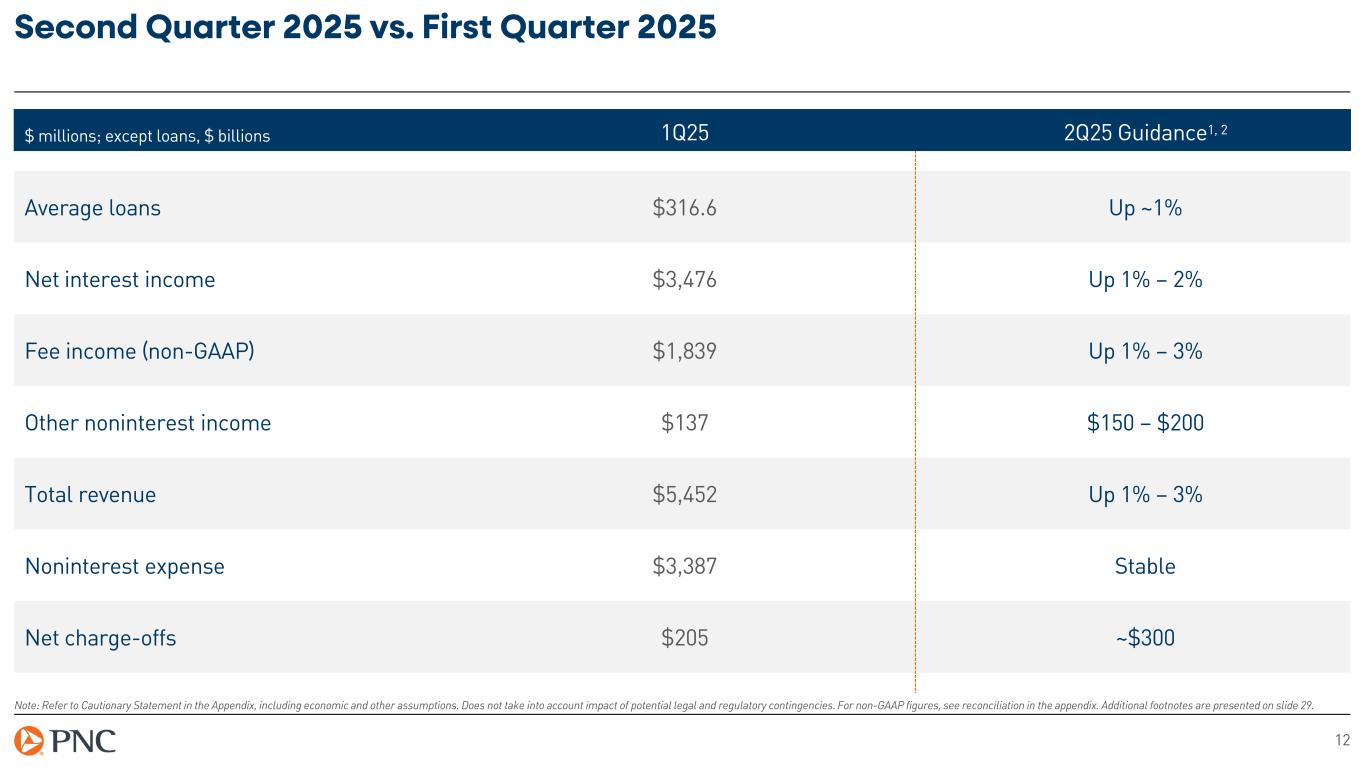
12 Second Quarter 2025 vs. First Quarter 2025 Note: Refer to Cautionary Statement in the Appendix, including economic and other assumptions. Does not take into account impact of potential legal and regulatory contingencies. For non-GAAP figures, see reconciliation in the appendix. Additional footnotes are presented on slide 29. $ millions; except loans, $ billions 1Q25 2Q25 Guidance1, 2 Average loans $316.6 Up ~1% Net interest income $3,476 Up 1% – 2% Fee income (non-GAAP) $1,839 Up 1% – 3% Other noninterest income $137 $150 – $200 Total revenue $5,452 Up 1% – 3% Noninterest expense $3,387 Stable Net charge-offs $205 ~$300
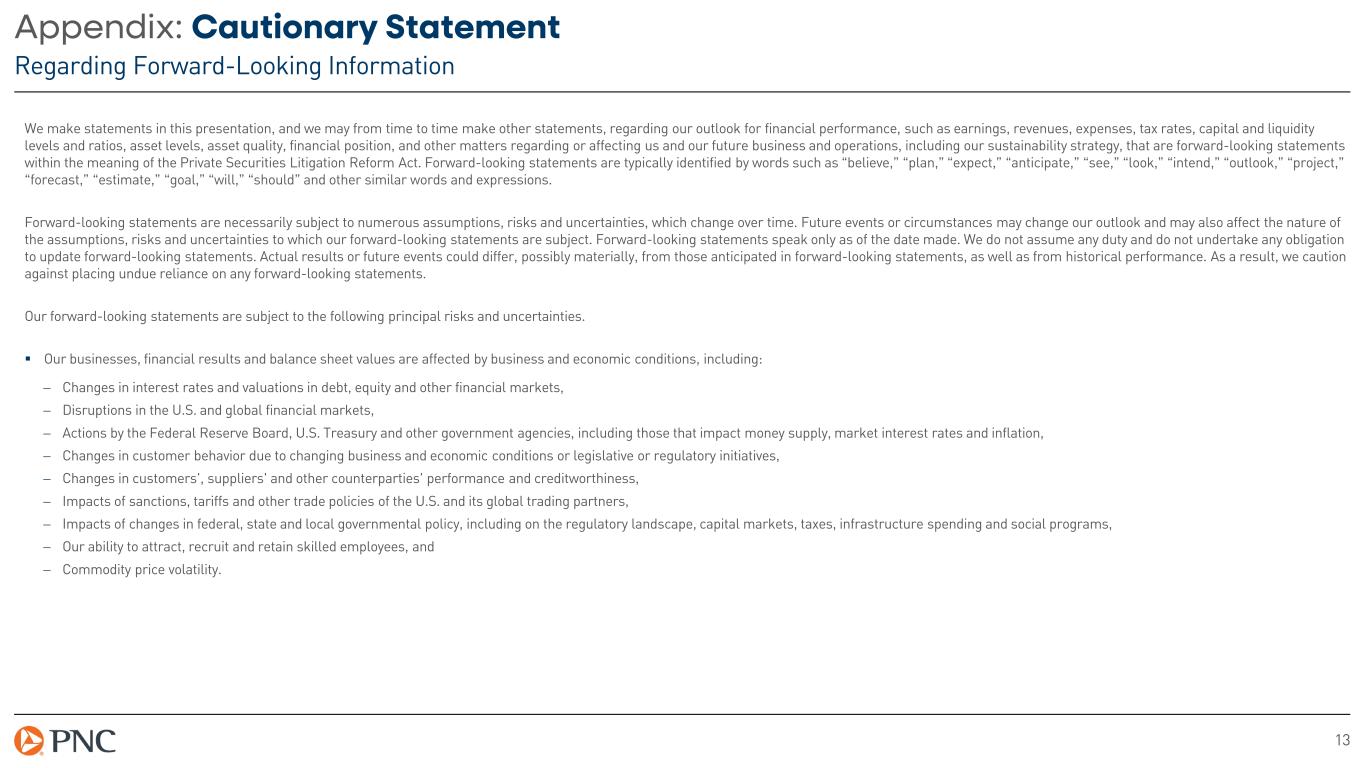
13 Appendix: Cautionary Statement Regarding Forward-Looking Information We make statements in this presentation, and we may from time to time make other statements, regarding our outlook for financial performance, such as earnings, revenues, expenses, tax rates, capital and liquidity levels and ratios, asset levels, asset quality, financial position, and other matters regarding or affecting us and our future business and operations, including our sustainability strategy, that are forward-looking statements within the meaning of the Private Securities Litigation Reform Act. Forward-looking statements are typically identified by words such as “believe,” “plan,” “expect,” “anticipate,” “see,” “look,” “intend,” “outlook,” “project,” “forecast,” “estimate,” “goal,” “will,” “should” and other similar words and expressions. Forward-looking statements are necessarily subject to numerous assumptions, risks and uncertainties, which change over time. Future events or circumstances may change our outlook and may also affect the nature of the assumptions, risks and uncertainties to which our forward-looking statements are subject. Forward-looking statements speak only as of the date made. We do not assume any duty and do not undertake any obligation to update forward-looking statements. Actual results or future events could differ, possibly materially, from those anticipated in forward-looking statements, as well as from historical performance. As a result, we caution against placing undue reliance on any forward-looking statements. Our forward-looking statements are subject to the following principal risks and uncertainties. Our businesses, financial results and balance sheet values are affected by business and economic conditions, including: − Changes in interest rates and valuations in debt, equity and other financial markets, − Disruptions in the U.S. and global financial markets, − Actions by the Federal Reserve Board, U.S. Treasury and other government agencies, including those that impact money supply, market interest rates and inflation, − Changes in customer behavior due to changing business and economic conditions or legislative or regulatory initiatives, − Changes in customers', suppliers' and other counterparties' performance and creditworthiness, − Impacts of sanctions, tariffs and other trade policies of the U.S. and its global trading partners, − Impacts of changes in federal, state and local governmental policy, including on the regulatory landscape, capital markets, taxes, infrastructure spending and social programs, − Our ability to attract, recruit and retain skilled employees, and − Commodity price volatility.
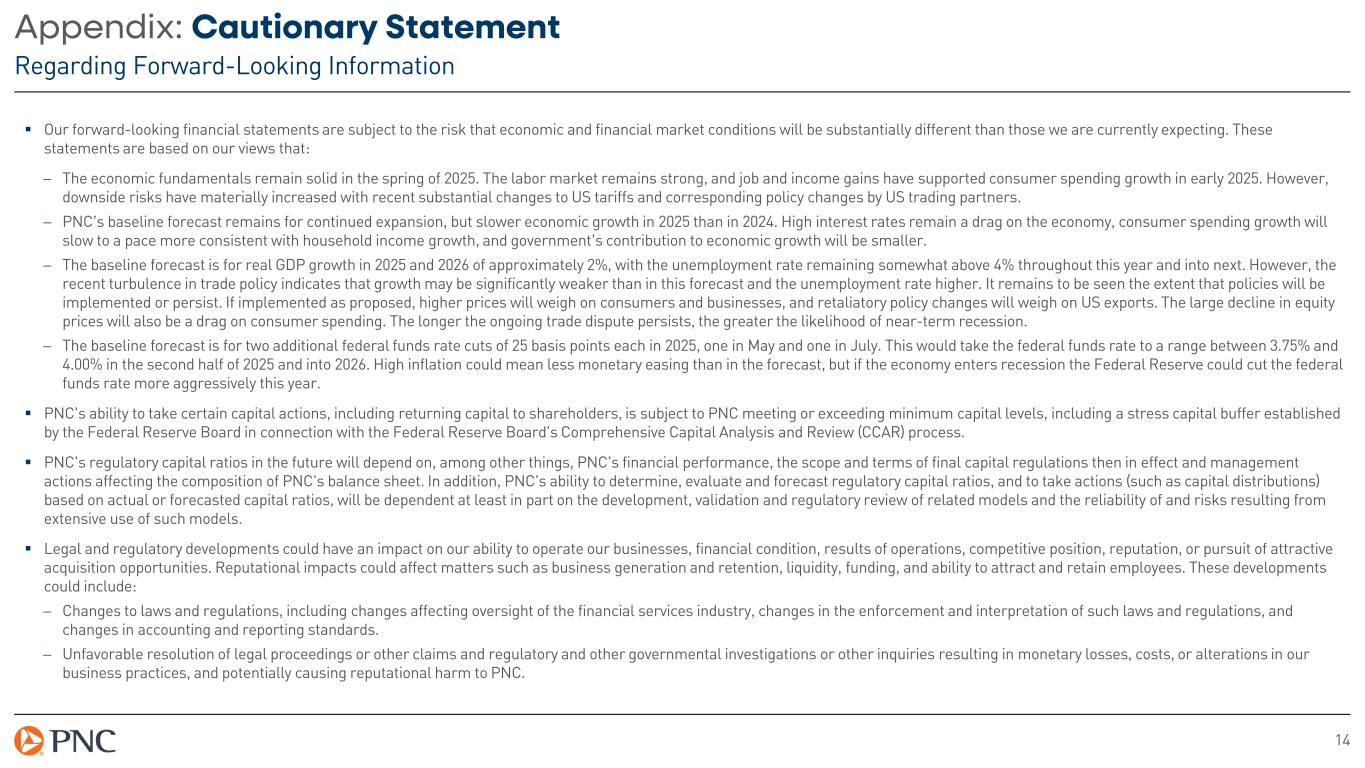
14 Appendix: Cautionary Statement Regarding Forward-Looking Information Our forward-looking financial statements are subject to the risk that economic and financial market conditions will be substantially different than those we are currently expecting. These statements are based on our views that: − The economic fundamentals remain solid in the spring of 2025. The labor market remains strong, and job and income gains have supported consumer spending growth in early 2025. However, downside risks have materially increased with recent substantial changes to US tariffs and corresponding policy changes by US trading partners. − PNC’s baseline forecast remains for continued expansion, but slower economic growth in 2025 than in 2024. High interest rates remain a drag on the economy, consumer spending growth will slow to a pace more consistent with household income growth, and government’s contribution to economic growth will be smaller. − The baseline forecast is for real GDP growth in 2025 and 2026 of approximately 2%, with the unemployment rate remaining somewhat above 4% throughout this year and into next. However, the recent turbulence in trade policy indicates that growth may be significantly weaker than in this forecast and the unemployment rate higher. It remains to be seen the extent that policies will be implemented or persist. If implemented as proposed, higher prices will weigh on consumers and businesses, and retaliatory policy changes will weigh on US exports. The large decline in equity prices will also be a drag on consumer spending. The longer the ongoing trade dispute persists, the greater the likelihood of near-term recession. − The baseline forecast is for two additional federal funds rate cuts of 25 basis points each in 2025, one in May and one in July. This would take the federal funds rate to a range between 3.75% and 4.00% in the second half of 2025 and into 2026. High inflation could mean less monetary easing than in the forecast, but if the economy enters recession the Federal Reserve could cut the federal funds rate more aggressively this year. PNC's ability to take certain capital actions, including returning capital to shareholders, is subject to PNC meeting or exceeding minimum capital levels, including a stress capital buffer established by the Federal Reserve Board in connection with the Federal Reserve Board's Comprehensive Capital Analysis and Review (CCAR) process. PNC's regulatory capital ratios in the future will depend on, among other things, PNC's financial performance, the scope and terms of final capital regulations then in effect and management actions affecting the composition of PNC's balance sheet. In addition, PNC's ability to determine, evaluate and forecast regulatory capital ratios, and to take actions (such as capital distributions) based on actual or forecasted capital ratios, will be dependent at least in part on the development, validation and regulatory review of related models and the reliability of and risks resulting from extensive use of such models. Legal and regulatory developments could have an impact on our ability to operate our businesses, financial condition, results of operations, competitive position, reputation, or pursuit of attractive acquisition opportunities. Reputational impacts could affect matters such as business generation and retention, liquidity, funding, and ability to attract and retain employees. These developments could include: − Changes to laws and regulations, including changes affecting oversight of the financial services industry, changes in the enforcement and interpretation of such laws and regulations, and changes in accounting and reporting standards. − Unfavorable resolution of legal proceedings or other claims and regulatory and other governmental investigations or other inquiries resulting in monetary losses, costs, or alterations in our business practices, and potentially causing reputational harm to PNC.

15 Appendix: Cautionary Statement Regarding Forward-Looking Information − Results of the regulatory examination and supervision process, including our failure to satisfy requirements of agreements with governmental agencies. − Costs associated with obtaining rights in intellectual property claimed by others and of adequacy of our intellectual property protection in general. Business and operating results are affected by our ability to identify and effectively manage risks inherent in our businesses, including, where appropriate, through effective use of systems and controls, third-party insurance, derivatives, and capital management techniques, and to meet evolving regulatory capital and liquidity standards. Our reputation and business and operating results may be affected by our ability to appropriately meet or address environmental, social or governance targets, goals, commitments or concerns that may arise. We grow our business in part through acquisitions and new strategic initiatives. Risks and uncertainties include those presented by the nature of the business acquired and strategic initiative, including in some cases those associated with our entry into new businesses or new geographic or other markets and risks resulting from our inexperience in those new areas, as well as risks and uncertainties related to the acquisition transactions themselves, regulatory issues, the integration of the acquired businesses into PNC after closing or any failure to execute strategic or operational plans. Competition can have an impact on customer acquisition, growth and retention and on credit spreads and product pricing, which can affect market share, deposits and revenues. Our ability to anticipate and respond to technological changes can also impact our ability to respond to customer needs and meet competitive demands. Business and operating results can also be affected by widespread manmade, natural and other disasters (including severe weather events), health emergencies, dislocations, geopolitical instabilities or events, terrorist activities, system failures or disruptions, security breaches, cyberattacks, international hostilities, or other extraordinary events beyond PNC's control through impacts on the economy and financial markets generally or on us or our counterparties, customers or third-party vendors and service providers specifically. We provide greater detail regarding these as well as other factors in our 2024 Form 10-K, including in the Risk Factors and Risk Management sections and the Legal Proceedings and Commitments Notes of the Notes To Consolidated Financial Statements, and in our subsequent SEC filings. Our forward-looking statements may also be subject to other risks and uncertainties, including those we may discuss elsewhere in this news release or in our SEC filings, accessible on the SEC's website at www.sec.gov and on our corporate website at www.pnc.com/secfilings. We have included these web addresses as inactive textual references only. Information on these websites is not part of this document.
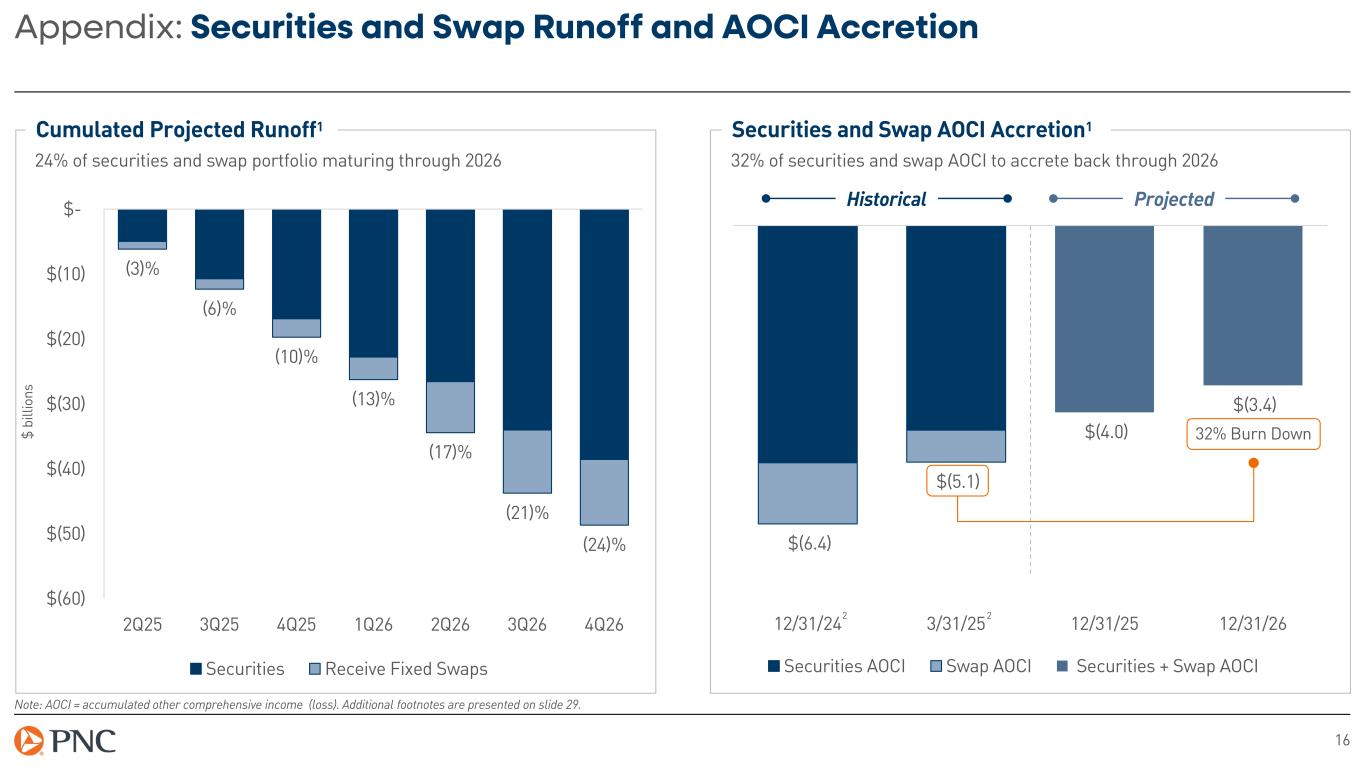
16 Appendix: Securities and Swap Runoff and AOCI Accretion Note: AOCI = accumulated other comprehensive income (loss). Additional footnotes are presented on slide 29. Cumulated Projected Runoff1 Securities and Swap AOCI Accretion1 24% of securities and swap portfolio maturing through 2026 32% of securities and swap AOCI to accrete back through 2026 (3)% (6)% (10)% (13)% (17)% (21)% (24)% $(60) $(50) $(40) $(30) $(20) $(10) $- 2Q25 3Q25 4Q25 1Q26 2Q26 3Q26 4Q26 Securities Receive Fixed Swaps $ bi lli on s $(6.4) $(5.1) $(4.0) $(3.4) 12/31/24 3/31/25 12/31/25 12/31/26 Securities AOCI Swap AOCI Securities + Swap AOCI ProjectedHistorical 32% Burn Down 2 2

17 Appendix: Commercial Real Estate (CRE) Portfolio CRE Portfolio Represents 10% of Total Loans Note: Totals may not sum due to rounding. As of 3/31/25 Total Loans Commercial Real Estate 10% Total $318.9 Billion PNC Commercial Real Estate Portfolio $ billions 3/31/25 % of Total Loans Multifamily $16.0 5.0% Office 6.3 2.0% Industrial / Warehouse 3.6 1.1% Retail 2.0 0.6% Hotel / Motel 1.6 0.5% Seniors Housing 1.5 0.5% Other 1.4 0.5% Total $32.3 10.1%
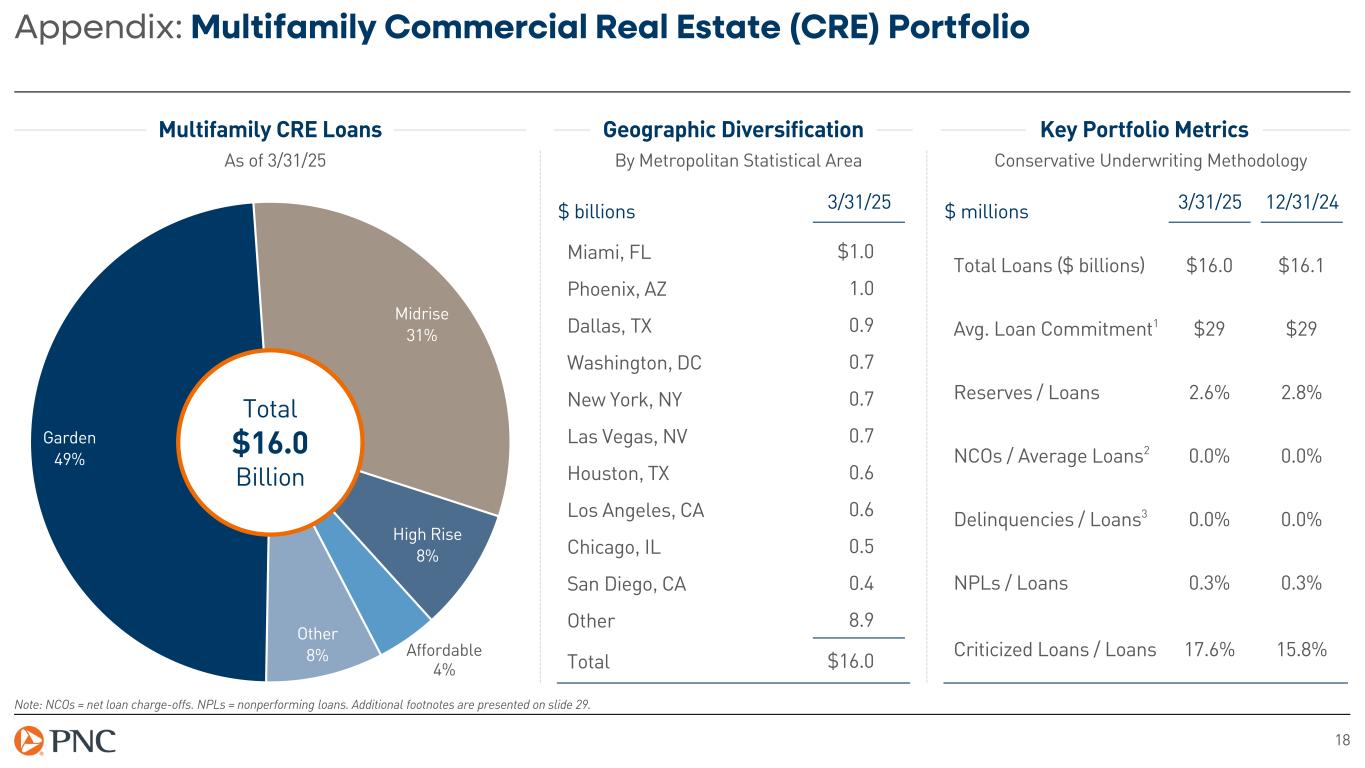
18 Appendix: Multifamily Commercial Real Estate (CRE) Portfolio Note: NCOs = net loan charge-offs. NPLs = nonperforming loans. Additional footnotes are presented on slide 29. As of 3/31/25 Multifamily CRE Loans Garden 49% Midrise 31% High Rise 8% Affordable 4% Other 8% Total $16.0 Billion Geographic Diversification By Metropolitan Statistical Area Key Portfolio Metrics Conservative Underwriting Methodology $ billions 3/31/25 Miami, FL $1.0 Phoenix, AZ 1.0 Dallas, TX 0.9 Washington, DC 0.7 New York, NY 0.7 Las Vegas, NV 0.7 Houston, TX 0.6 Los Angeles, CA 0.6 Chicago, IL 0.5 San Diego, CA 0.4 Other 8.9 Total $16.0 $ millions 3/31/25 12/31/24 Total Loans ($ billions) $16.0 $16.1 Avg. Loan Commitment1 $29 $29 Reserves / Loans 2.6% 2.8% NCOs / Average Loans2 0.0% 0.0% Delinquencies / Loans3 0.0% 0.0% NPLs / Loans 0.3% 0.3% Criticized Loans / Loans 17.6% 15.8%

19 Appendix: Office Commercial Real Estate (CRE) Portfolio Note: Totals may not foot due to rounding. NCOs = net loan charge-offs. NPLs = nonperforming loans. Additional footnotes are presented on slide 29. Geographic Diversification By Metropolitan Statistical Area Key Portfolio Metrics Conservative Underwriting Methodology $ billions 3/31/25 Los Angeles, CA $0.9 Washington, DC 0.8 Dallas, TX 0.4 San Francisco, CA 0.3 New York, NY 0.3 Chicago, IL 0.2 San Diego, CA 0.2 Baltimore, MD 0.2 Boston, MA 0.2 Birmingham, AL 0.2 Other 2.5 Total $6.3 $ millions 3/31/25 12/31/24 Total Loans ($ billions) $6.3 $6.7 Avg. Loan Commitment1 $34 $34 Reserves / Loans 13.4% 13.3% NCOs / Average Loans2 3.8% 4.2% Delinquencies / Loans3 0.0% 0.6% NPLs / Loans 12.1% 12.6% Criticized Loans / Loans 32.6% 30.5% Multi- Tenant 55% Single- Tenant 15% Medical 16% Government 12% Other 2% Total $6.3 Billion As of 3/31/25 Office CRE Loans
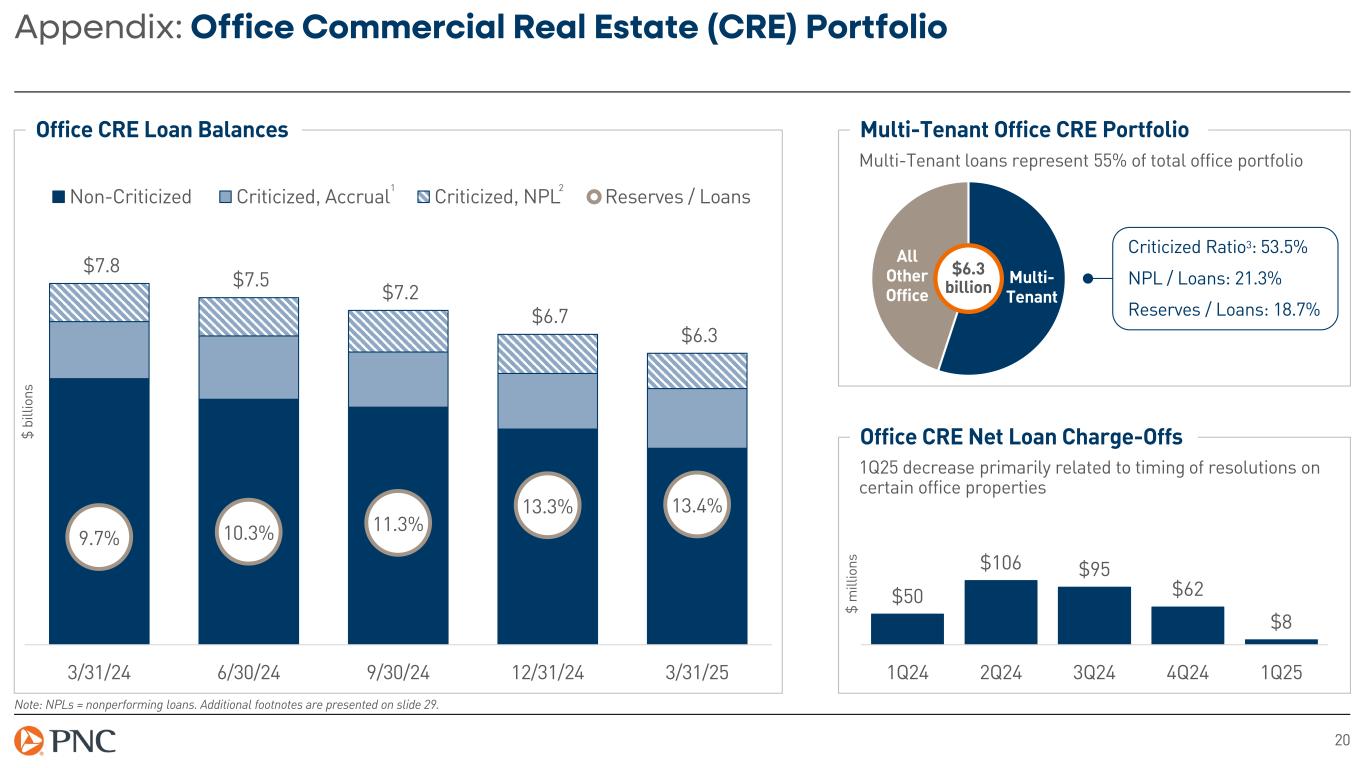
$50 $106 $95 $62 $8 1Q24 2Q24 3Q24 4Q24 1Q25 20 Appendix: Office Commercial Real Estate (CRE) Portfolio Note: NPLs = nonperforming loans. Additional footnotes are presented on slide 29. Office CRE Loan Balances Multi-Tenant Office CRE Portfolio Multi-Tenant loans represent 55% of total office portfolio Office CRE Net Loan Charge-Offs 1Q25 decrease primarily related to timing of resolutions on certain office properties $ m ill io ns Multi- Tenant All Other Office Criticized Ratio3: 53.5% NPL / Loans: 21.3% Reserves / Loans: 18.7% $6.3 billion $7.8 $7.5 $7.2 $6.7 $6.3 9.7% 10.3% 11.3% 13.3% 13.4% 3/31/24 6/30/24 9/30/24 12/31/24 3/31/25 Non-Criticized Criticized, Accrual Criticized, NPL Reserves / Loans $ bi lli on s 1 2
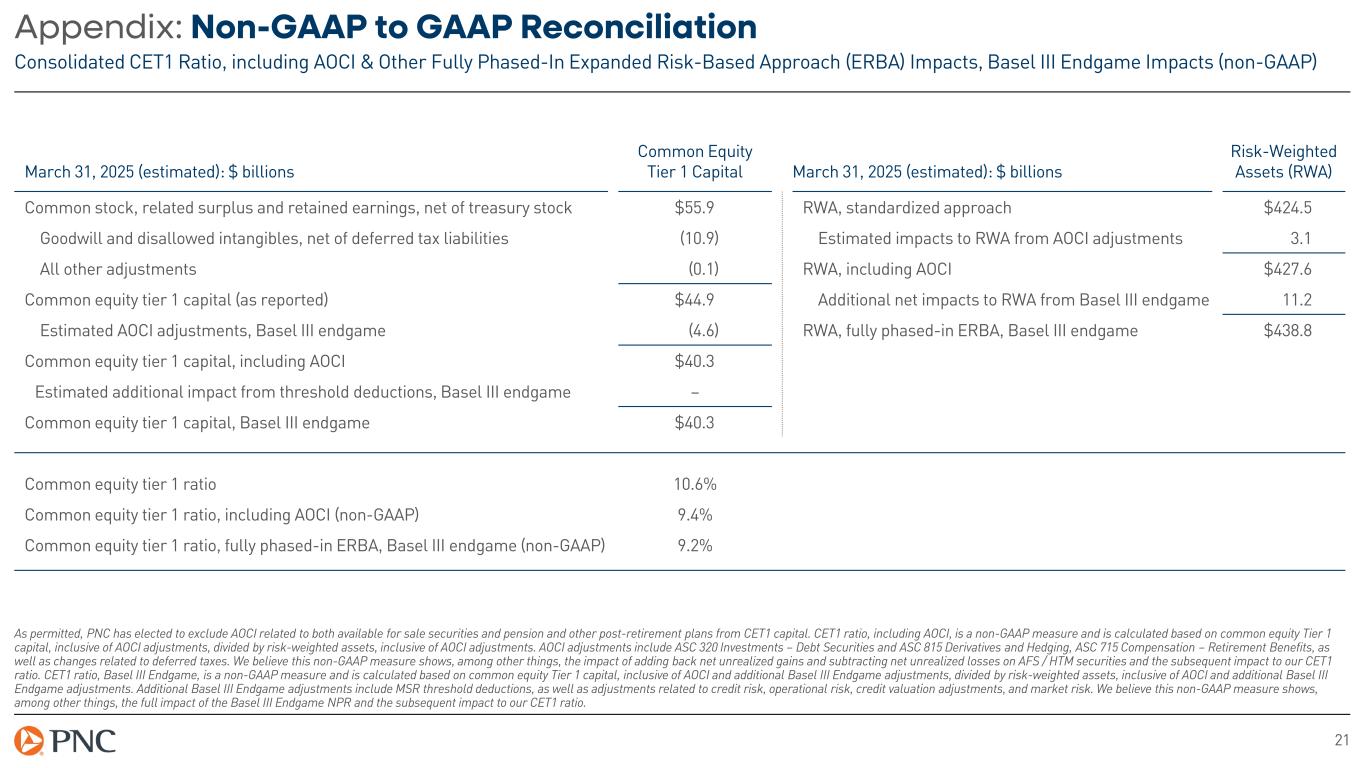
21 Appendix: Non-GAAP to GAAP Reconciliation Consolidated CET1 Ratio, including AOCI & Other Fully Phased-In Expanded Risk-Based Approach (ERBA) Impacts, Basel III Endgame Impacts (non-GAAP) As permitted, PNC has elected to exclude AOCI related to both available for sale securities and pension and other post-retirement plans from CET1 capital. CET1 ratio, including AOCI, is a non-GAAP measure and is calculated based on common equity Tier 1 capital, inclusive of AOCI adjustments, divided by risk-weighted assets, inclusive of AOCI adjustments. AOCI adjustments include ASC 320 Investments – Debt Securities and ASC 815 Derivatives and Hedging, ASC 715 Compensation – Retirement Benefits, as well as changes related to deferred taxes. We believe this non-GAAP measure shows, among other things, the impact of adding back net unrealized gains and subtracting net unrealized losses on AFS / HTM securities and the subsequent impact to our CET1 ratio. CET1 ratio, Basel III Endgame, is a non-GAAP measure and is calculated based on common equity Tier 1 capital, inclusive of AOCI and additional Basel III Endgame adjustments, divided by risk-weighted assets, inclusive of AOCI and additional Basel III Endgame adjustments. Additional Basel III Endgame adjustments include MSR threshold deductions, as well as adjustments related to credit risk, operational risk, credit valuation adjustments, and market risk. We believe this non-GAAP measure shows, among other things, the full impact of the Basel III Endgame NPR and the subsequent impact to our CET1 ratio. March 31, 2025 (estimated): $ billions Common Equity Tier 1 Capital March 31, 2025 (estimated): $ billions Risk-Weighted Assets (RWA) Common stock, related surplus and retained earnings, net of treasury stock $55.9 RWA, standardized approach $424.5 Goodwill and disallowed intangibles, net of deferred tax liabilities (10.9) Estimated impacts to RWA from AOCI adjustments 3.1 All other adjustments (0.1) RWA, including AOCI $427.6 Common equity tier 1 capital (as reported) $44.9 Additional net impacts to RWA from Basel III endgame 11.2 Estimated AOCI adjustments, Basel III endgame (4.6) RWA, fully phased-in ERBA, Basel III endgame $438.8 Common equity tier 1 capital, including AOCI $40.3 Estimated additional impact from threshold deductions, Basel III endgame – Common equity tier 1 capital, Basel III endgame $40.3 Common equity tier 1 ratio 10.6% Common equity tier 1 ratio, including AOCI (non-GAAP) 9.4% Common equity tier 1 ratio, fully phased-in ERBA, Basel III endgame (non-GAAP) 9.2%
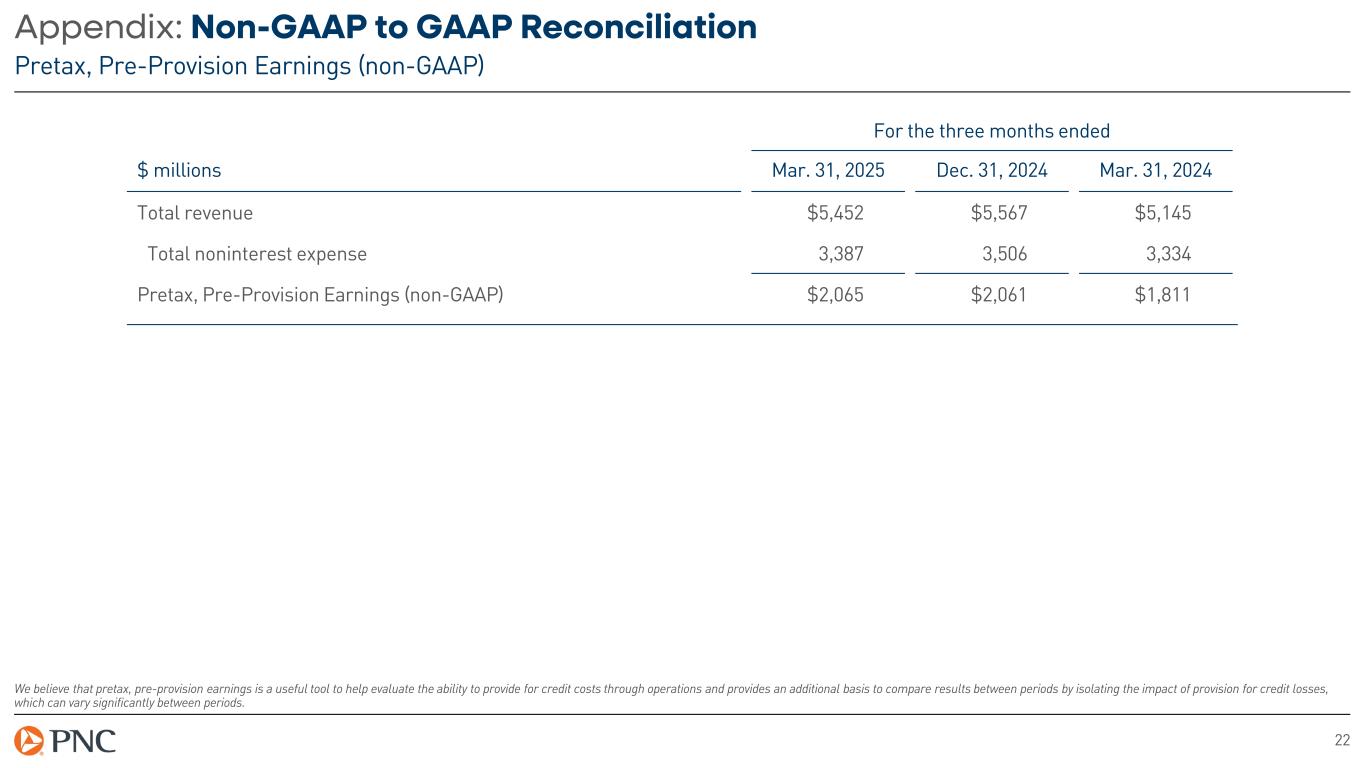
22 Appendix: Non-GAAP to GAAP Reconciliation Pretax, Pre-Provision Earnings (non-GAAP) For the three months ended $ millions Mar. 31, 2025 Dec. 31, 2024 Mar. 31, 2024 Total revenue $5,452 $5,567 $5,145 Total noninterest expense 3,387 3,506 3,334 Pretax, Pre-Provision Earnings (non-GAAP) $2,065 $2,061 $1,811 We believe that pretax, pre-provision earnings is a useful tool to help evaluate the ability to provide for credit costs through operations and provides an additional basis to compare results between periods by isolating the impact of provision for credit losses, which can vary significantly between periods.
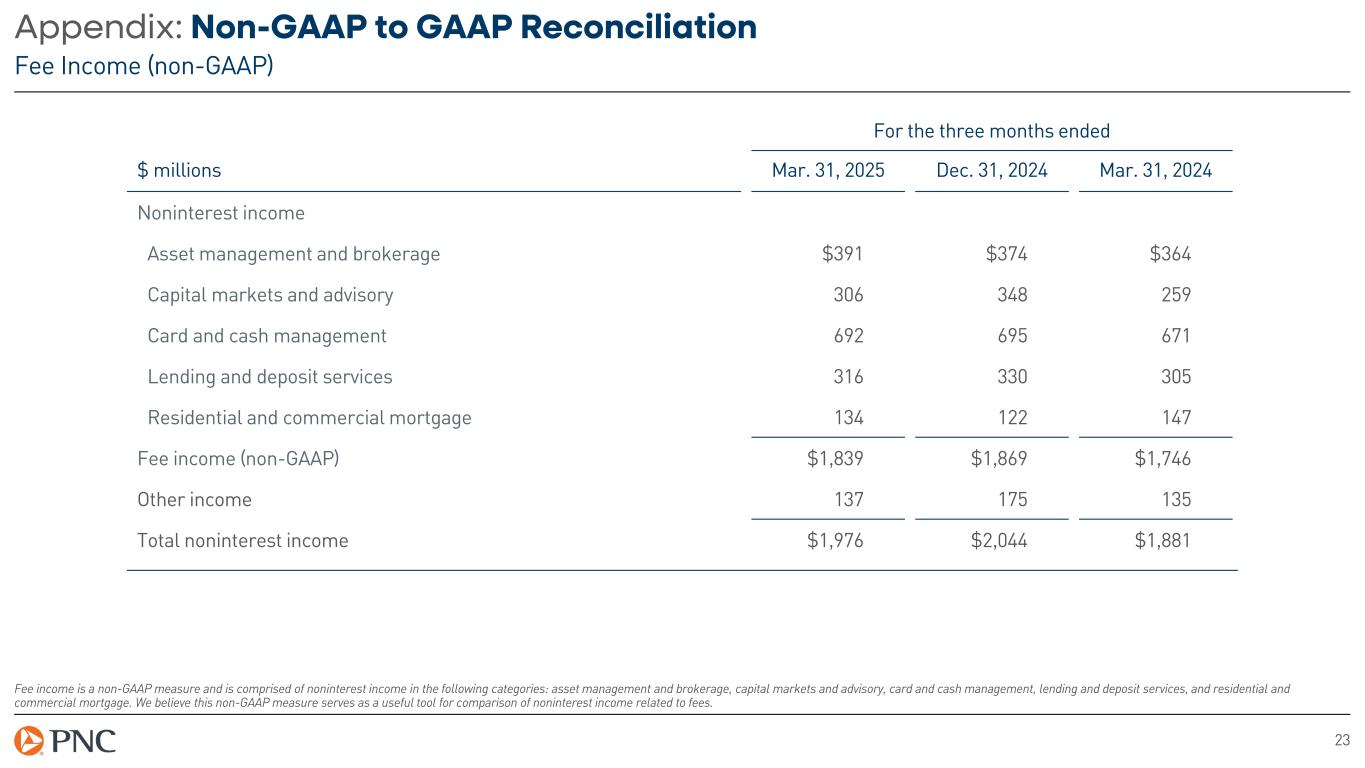
23 Appendix: Non-GAAP to GAAP Reconciliation Fee Income (non-GAAP) For the three months ended $ millions Mar. 31, 2025 Dec. 31, 2024 Mar. 31, 2024 Noninterest income Asset management and brokerage $391 $374 $364 Capital markets and advisory 306 348 259 Card and cash management 692 695 671 Lending and deposit services 316 330 305 Residential and commercial mortgage 134 122 147 Fee income (non-GAAP) $1,839 $1,869 $1,746 Other income 137 175 135 Total noninterest income $1,976 $2,044 $1,881 Fee income is a non-GAAP measure and is comprised of noninterest income in the following categories: asset management and brokerage, capital markets and advisory, card and cash management, lending and deposit services, and residential and commercial mortgage. We believe this non-GAAP measure serves as a useful tool for comparison of noninterest income related to fees.
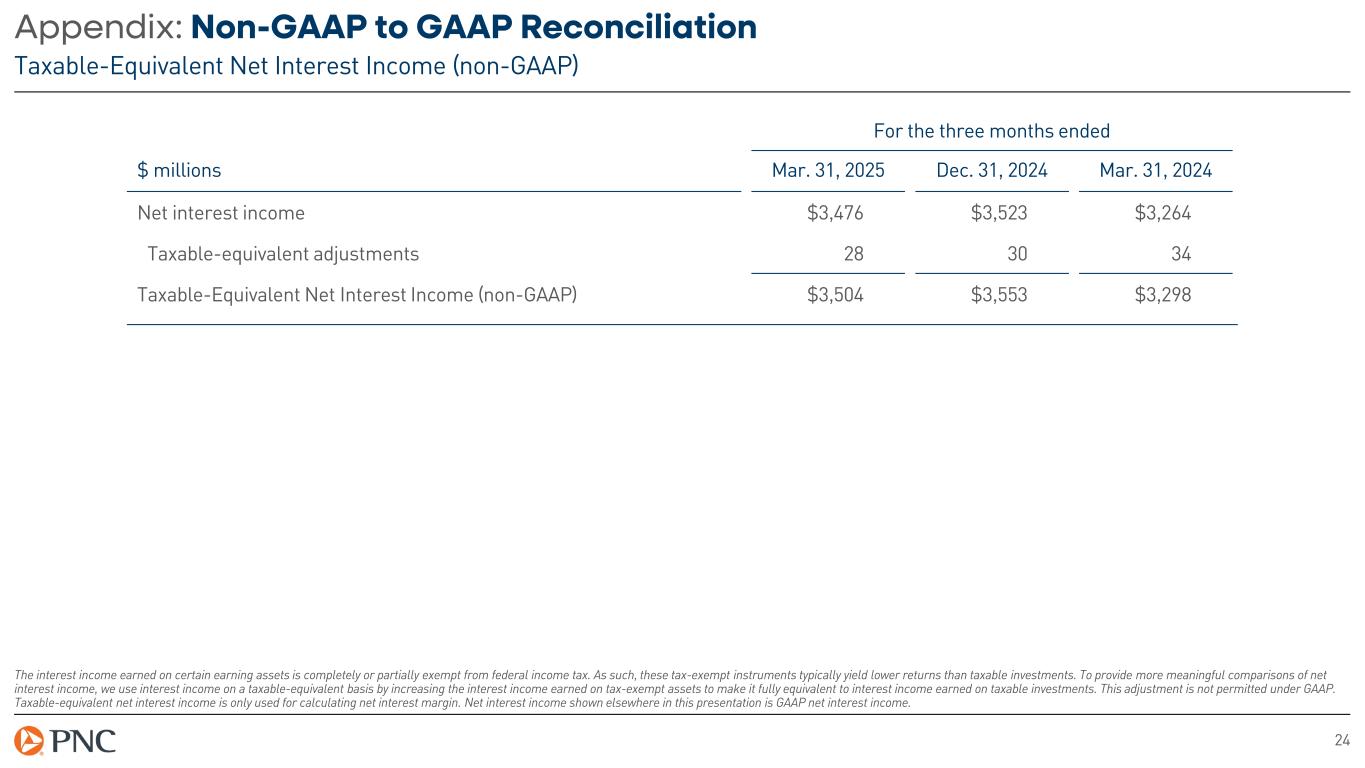
24 Appendix: Non-GAAP to GAAP Reconciliation Taxable-Equivalent Net Interest Income (non-GAAP) The interest income earned on certain earning assets is completely or partially exempt from federal income tax. As such, these tax-exempt instruments typically yield lower returns than taxable investments. To provide more meaningful comparisons of net interest income, we use interest income on a taxable-equivalent basis by increasing the interest income earned on tax-exempt assets to make it fully equivalent to interest income earned on taxable investments. This adjustment is not permitted under GAAP. Taxable-equivalent net interest income is only used for calculating net interest margin. Net interest income shown elsewhere in this presentation is GAAP net interest income. For the three months ended $ millions Mar. 31, 2025 Dec. 31, 2024 Mar. 31, 2024 Net interest income $3,476 $3,523 $3,264 Taxable-equivalent adjustments 28 30 34 Taxable-Equivalent Net Interest Income (non-GAAP) $3,504 $3,553 $3,298
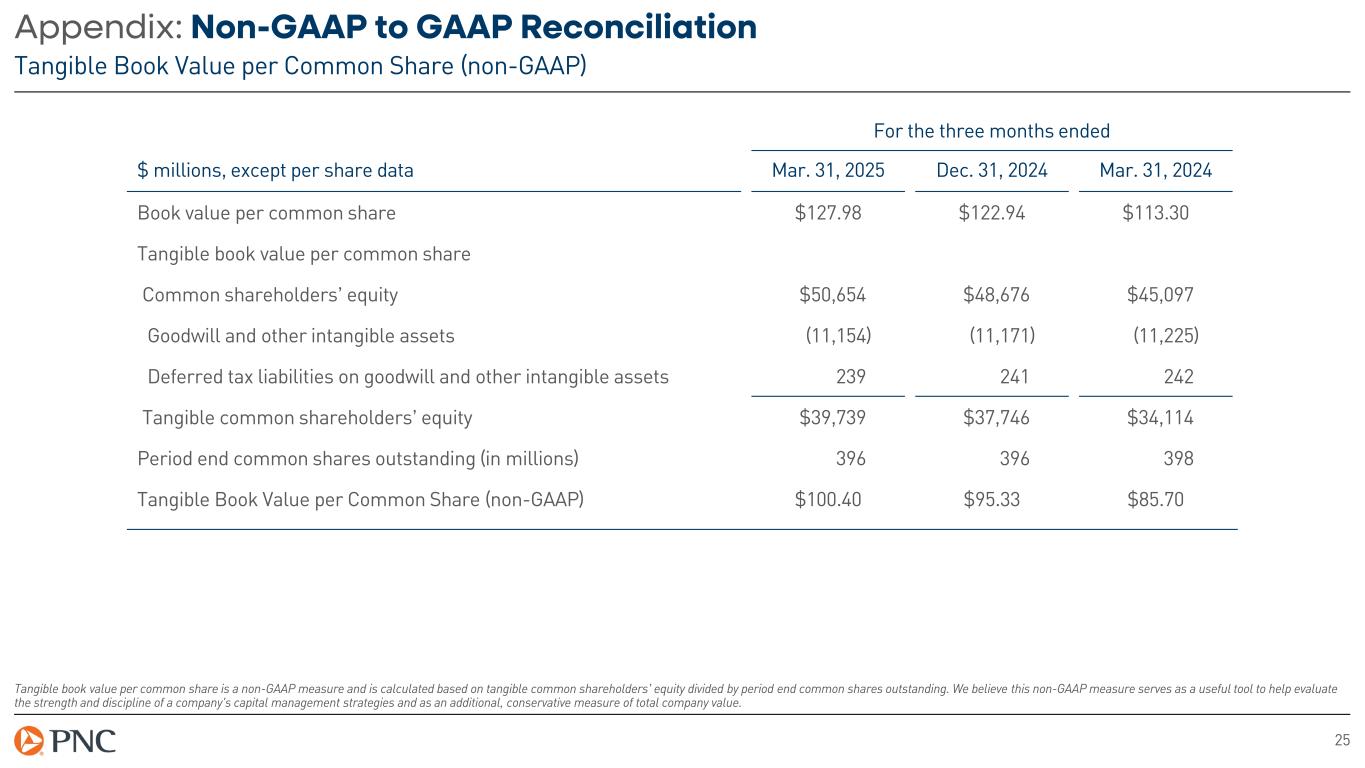
25 Appendix: Non-GAAP to GAAP Reconciliation Tangible Book Value per Common Share (non-GAAP) Tangible book value per common share is a non-GAAP measure and is calculated based on tangible common shareholders’ equity divided by period end common shares outstanding. We believe this non-GAAP measure serves as a useful tool to help evaluate the strength and discipline of a company's capital management strategies and as an additional, conservative measure of total company value. For the three months ended $ millions, except per share data Mar. 31, 2025 Dec. 31, 2024 Mar. 31, 2024 Book value per common share $127.98 $122.94 $113.30 Tangible book value per common share Common shareholders’ equity $50,654 $48,676 $45,097 Goodwill and other intangible assets (11,154) (11,171) (11,225) Deferred tax liabilities on goodwill and other intangible assets 239 241 242 Tangible common shareholders’ equity $39,739 $37,746 $34,114 Period end common shares outstanding (in millions) 396 396 398 Tangible Book Value per Common Share (non-GAAP) $100.40 $95.33 $85.70
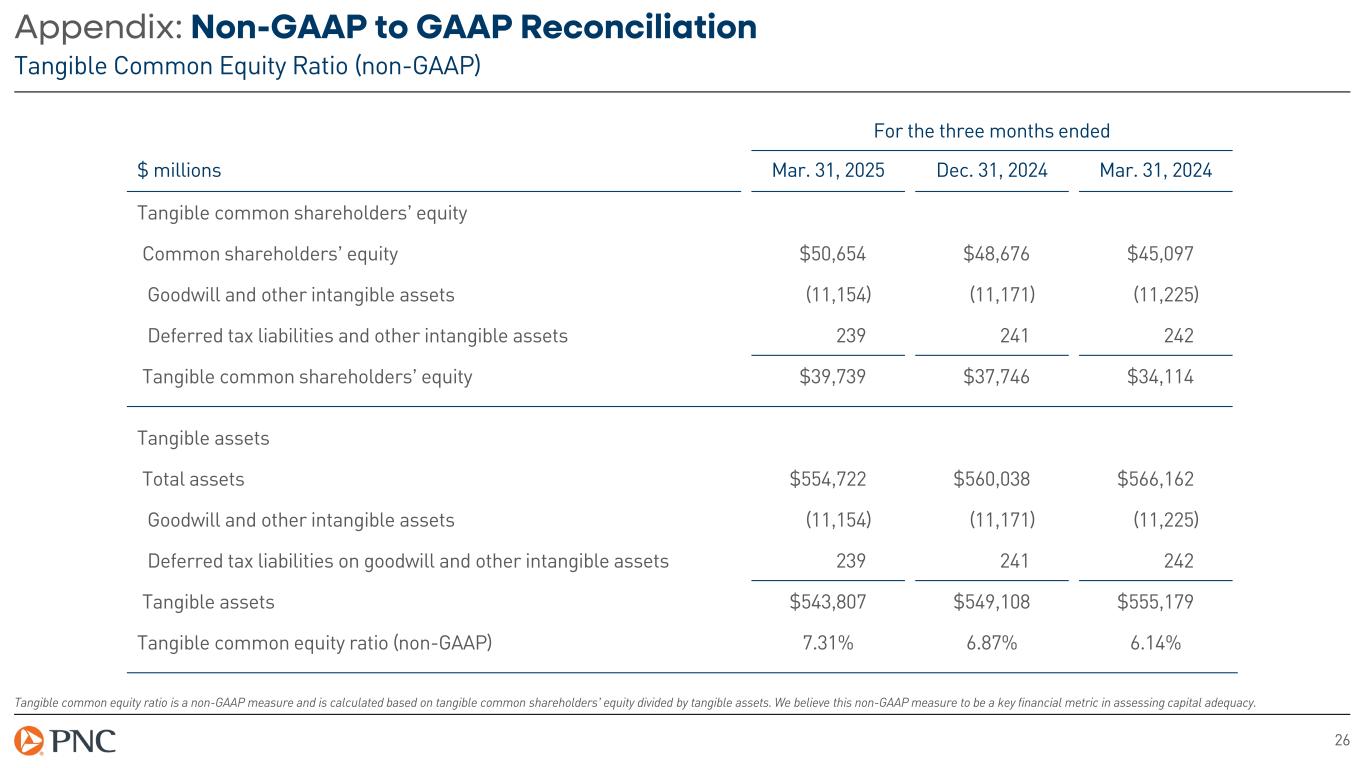
26 Appendix: Non-GAAP to GAAP Reconciliation Tangible Common Equity Ratio (non-GAAP) Tangible common equity ratio is a non-GAAP measure and is calculated based on tangible common shareholders’ equity divided by tangible assets. We believe this non-GAAP measure to be a key financial metric in assessing capital adequacy. For the three months ended $ millions Mar. 31, 2025 Dec. 31, 2024 Mar. 31, 2024 Tangible common shareholders’ equity Common shareholders’ equity $50,654 $48,676 $45,097 Goodwill and other intangible assets (11,154) (11,171) (11,225) Deferred tax liabilities and other intangible assets 239 241 242 Tangible common shareholders’ equity $39,739 $37,746 $34,114 Tangible assets Total assets $554,722 $560,038 $566,162 Goodwill and other intangible assets (11,154) (11,171) (11,225) Deferred tax liabilities on goodwill and other intangible assets 239 241 242 Tangible assets $543,807 $549,108 $555,179 Tangible common equity ratio (non-GAAP) 7.31% 6.87% 6.14%
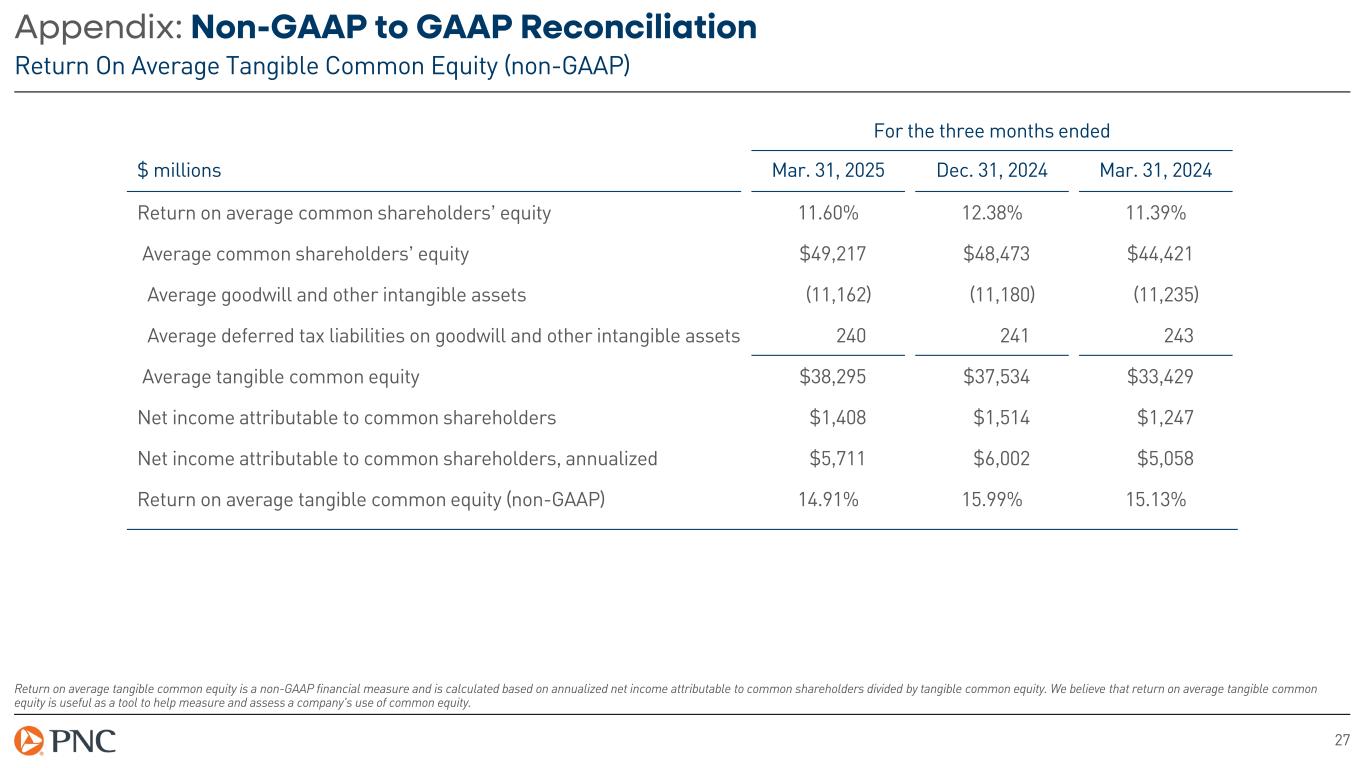
27 Appendix: Non-GAAP to GAAP Reconciliation Return On Average Tangible Common Equity (non-GAAP) Return on average tangible common equity is a non-GAAP financial measure and is calculated based on annualized net income attributable to common shareholders divided by tangible common equity. We believe that return on average tangible common equity is useful as a tool to help measure and assess a company's use of common equity. For the three months ended $ millions Mar. 31, 2025 Dec. 31, 2024 Mar. 31, 2024 Return on average common shareholders’ equity 11.60% 12.38% 11.39% Average common shareholders’ equity $49,217 $48,473 $44,421 Average goodwill and other intangible assets (11,162) (11,180) (11,235) Average deferred tax liabilities on goodwill and other intangible assets 240 241 243 Average tangible common equity $38,295 $37,534 $33,429 Net income attributable to common shareholders $1,408 $1,514 $1,247 Net income attributable to common shareholders, annualized $5,711 $6,002 $5,058 Return on average tangible common equity (non-GAAP) 14.91% 15.99% 15.13%
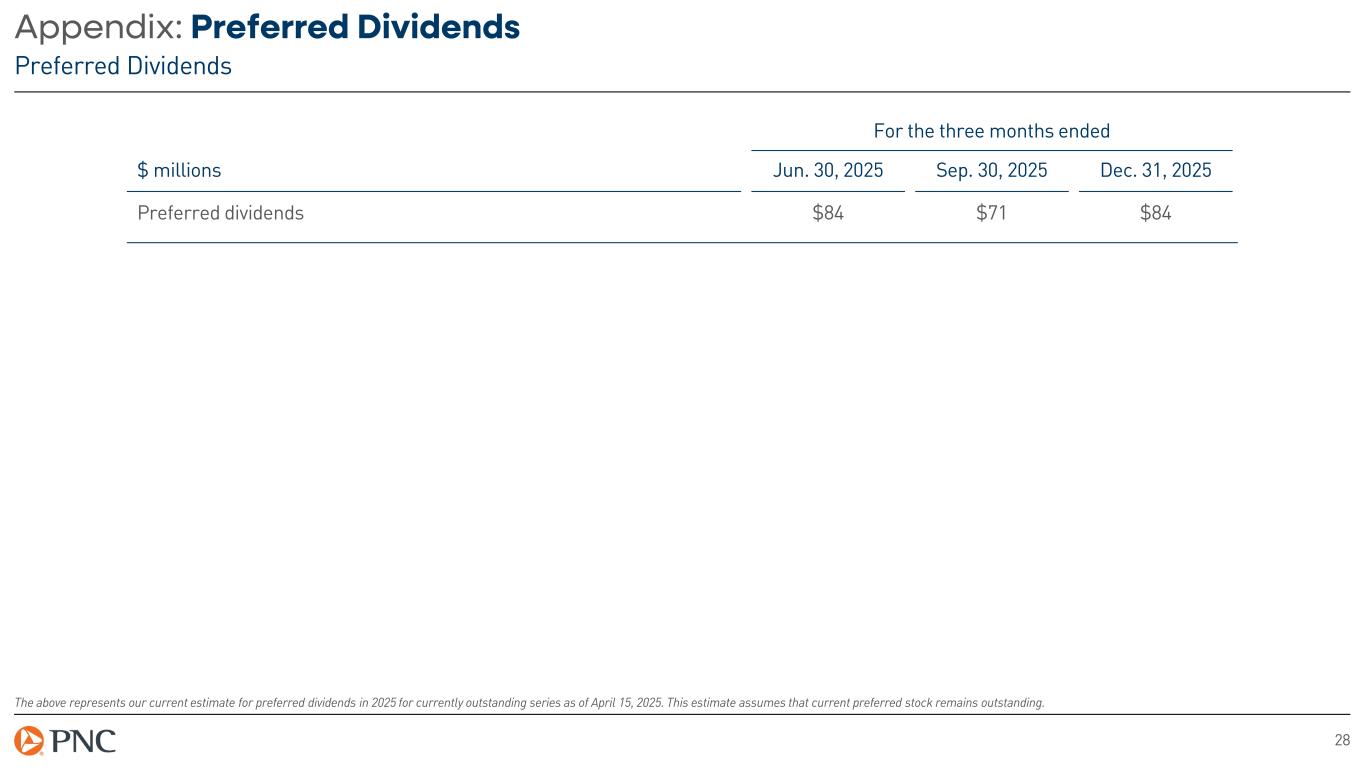
28 Appendix: Preferred Dividends Preferred Dividends The above represents our current estimate for preferred dividends in 2025 for currently outstanding series as of April 15, 2025. This estimate assumes that current preferred stock remains outstanding. For the three months ended $ millions Jun. 30, 2025 Sep. 30, 2025 Dec. 31, 2025 Preferred dividends $84 $71 $84

29 Earnings Presentation Footnotes Slide 2 – Solid 1Q25 Results 1. Net charge-off ratio represents annualized net loan charge-offs to average loans for the three months ended. 2. Basel III common equity Tier (CET) 1 capital ratio – 3/31/25 ratio as used in this presentation is estimated. Details of the calculation are in the financial highlights section of the earnings release. Slide 5 – Well-Positioned Investment Securities and Receive Fixed Swaps Portfolios 1. AFS - Floating include floating available for sale securities and available for sale securities swapped to floating 2. As of 3/31/25, the receive fixed rate on forward starting swaps was 4.09% and the receive fixed rate on the total swap portfolio, including active and forward starting swaps, was 3.68%. Slide 6 – Stable Deposit Base 1. Cumulative deposit beta is calculated as the change in deposit rate paid on total interest-bearing deposits divided by the change in the upper level of the average stated Federal Funds rate range since August 2024, the start of the current easing rate cycle. Slide 10 – Strong Credit Quality; NPLs and Net Charge-offs Declined 1. Delinquencies represent accruing loans past due 30 days or more. Delinquencies to Total Loans represent delinquencies divided by period end loans. 2. Net loan charge-offs (NCOs) / Average Loans represent annualized net loan charge-offs to average loans for the three months ended. 3. CRE net loan charge-offs (CRE NCOs) represent commercial real estate net loan charge offs. Net loan charge-offs, ex. commercial real estate (NCOs, ex. CRE) represent net loan charge-offs excluding commercial real estate net loan charge-offs. Slide 11 – Full Year 2025 vs. Full Year 2024 1. Average loans, spot loans, net interest income, noninterest income, total revenue and noninterest expense outlooks represent estimated percentage change for 2025 compared to the respective 2024 figures presented in the table. 2. The 2025 guidance range for total revenue and noninterest income does not forecast net securities gains or losses and activities related to Visa Class B common shares. Slide 12 – Second Quarter 2025 vs. First Quarter 2025 1. Average loans, net interest income, fee income, total revenue and noninterest expense outlooks represent estimated percentage change for 2Q25 compared to the respective 1Q25 figures presented in the table. 2. The 2Q25 guidance range for total revenue and other noninterest income does not forecast net securities gains or losses and activities related to Visa Class B common shares. Slide 16 – Appendix: Securities and Swap Runoff and AOCI Accretion 1. Cumulative projected runoff and accumulated other comprehensive income (AOCI) accretion are calculated along market implied forward interest rates as of 3/31/25, and captures scheduled principal payments, contractual maturities, and projected prepayments using internally validated models / assumptions. This represents our portfolio as of 3/31/25 and does not reflect future changes in composition of the securities portfolio. 2. Accumulated other comprehensive income (AOCI) of negative $6.4 billion as of 12/31/24 and negative $5.1 billion as of 3/31/25 represents accumulated other comprehensive income (AOCI) related to ASC 320 Investments – Debt Securities and ASC 815 Derivatives and Hedging but excludes approximately negative $150 million as of 3/31/25 and 12/31/24 of AOCI related to ASC 715 Compensation – Retirement Benefits and ASC 830 Foreign Currency Matters. Slide 18 – Appendix: Multifamily Commercial Real Estate (CRE) Portfolio 1. Average loan commitment for PNC Real Estate multifamily loans. 2. Net loan charge-offs (NCOs) / Average Loans represents net loan charge-offs to average loans for the last twelve-month period. 3. Delinquencies represent accruing loans past due 30 days or more. Delinquencies to Total Loans represent delinquencies divided by period end loans. Slide 19 – Appendix: Office Commercial Real Estate (CRE) Portfolio 1. Average loan commitment for PNC Real Estate office loans. 2. Net loan charge-offs (NCOs) / Average Loans represents net loan charge-offs to average loans for the last twelve-month period. 3. Delinquencies represent accruing loans past due 30 days or more. Delinquencies to Total Loans represent delinquencies divided by period end loans. Slide 20 – Appendix: Office Commercial Real Estate (CRE) Portfolio 1. Criticized, accrual loans represent loans that are designated as criticized, but still accruing. 2. Criticized, nonperforming (NPL) loans represent loans that are designated as criticized and nonperforming. 3. Criticized ratio represents criticized loans / total loans.